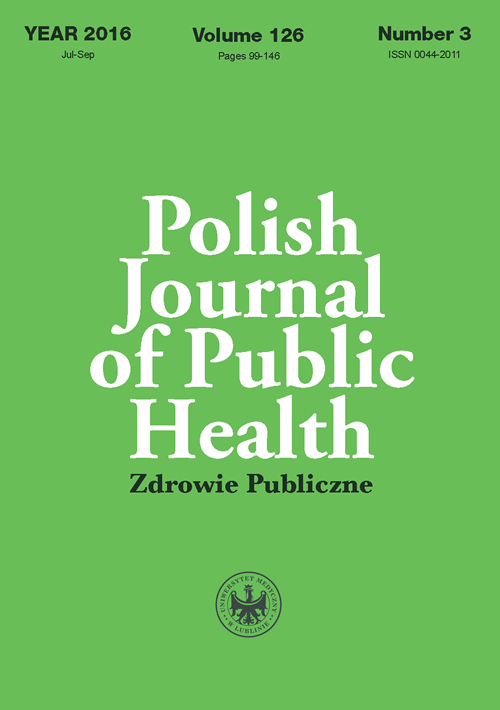Do duties of students of medicine be cause for stress?
DOI:
https://doi.org/10.1515/pjph-2016-0025Keywords:
responsibilities, students, teaching load, stressAbstract
Introduction. For young adults, one of the sources of peer interaction problems is the fact that they are burdened with an increasing number of duties and their pace of life increases. Since they are usually burdened with huge amount of study material, medicine students are particularly vulnerable.
Aim. The aim of this work was to determine the relationship between their obligations, stress levels and their peer or family relationships.
Material and methods. The study involved 242 students (148 women and 94 men) of the first year of daily studies, aged 18-30 (median – 20 years). The assessment was performed in March 2016, and the research tool was an anonymous survey. This took into account, inter alia, data on the demands of their studies, and their peer and family affinities.
Results. Using the results, around 71% of all respondents consider themselves to be over-burdened with the obligations resulting from their choice of study. Among these, women were more likely to self-assess themselves as overburdened (65%). Moreover, out of all respondents, approx. 27% of all, considered excessive workload as a major source of stress. This, however, does not significantly affect their peer and family relationships, because approx. 95% of all respondents consider such these to be be either good or rather good.
Conclusions. Medical students are burdened with responsibilities. This can be a source of stress, but overall, does not affect social and family associations.
References
1. Behere SP, Yadav R, Behere PB. A Comparative study of stress among students of medicine, engineering, and nursing. Indian J Psychol Med. 2011;33(2):145-8.
2. Dutta AP, Pyles MA, Miederhoff PA. Stress in health professions students: myth or reality? A review of the existing literature. J Natl Black Nurses Assoc. 2005;16(1):63-8.
3. Mojs E, Warchoł-Biedermann K, Głowacka MD, et al. Are students prone to depression and suicidal thoughts? Assessment of the risk of depression in university students from rural and urban areas. Ann Agric Environ Med. 2012;19(4):770-4.
4. Mojs E, Warchoł-Biedermann K, Głowacka MD, et al. Are students prone to depression and suicidal thoughts? Arch Med Sci. 2015;11(3):605-11.
5. Siamak K, Hashim Intan HM, Mohd-Zaharim N. Perceived stress, positive-negative emotions, personal values and perceived social support in Malaysian undergraduate students. Int J Psychol Behav Sci. 2012;2(1):1-8.
6. Heitzman J. Zagrożenia stanu zdrowia psychicznego Polaków. Nauka. 2010;4:53-9.
7. Woynarowska B. Edukacja zdrowotna. Podręcznik akademicki. Warszawa: PWN; 2010.
8. Marcinkowska U, Lau K, Jośko-Ochojska J. O potrzebie kształcenia studentów medycyny w aspekcie wiedzy o stresie – w ramach zajęć fakultatywnych. Hygeia Public Health. 2013;48(2):152-5.
9. Skrzypek M, Piątkowski W, Brysiewicz A, Wszędyrówny M. Analiza jakości życia studentów w kontekście stylu radzenia sobie ze stresem. Raport z badań. Ann Universitatis Mariae Curie-Skłodowska Lublin. 2001;24(21):261-75.
10. Ziemska B, Marcinkowski JT. Badania nad stresem psychologicznym związanym ze studiami medycznymi. Now Lek. 2008;77(2):120-5.
11. Andrews B, Wilding JM. The relation of depression and anxiety to life-stress and achievement in students. Br J Psychol. 2004;95(4):509-22.
12. Zaid ZA, Chan SC, Ho JJ. Emotional disorders among medical students in a Malaysian private medical school. Singapore Med J. 2007;48(10):895-9.
13. Baran S, Teul I, Lorkowski J. Poziom dystresu jako wskaźnik zdrowia psychicznego młodzieży akademickiej. Ann Acad Med Stetin. Roczniki Pomorskiej Akademii Medycznej w Szczecinie 2012;58(2):17-21.
14. Dyrbye LN, Thomas MR, Shanafelt TD. Systematic review of depression, anxiety, and other indicators of psychological distress among U.S. and Canadian medical students. Acad Med. 2006;81(4):354-73.
15. Marek K, Białoń P, Wichowicz H, et al. Przesiewowa ocena rozpowszechnienia objawów depresyjnych i lękowych wśród studentów Akademii Medycznej w Gdańsku. Psychiatr. 2005;2(4):217-24.
Downloads
Published
Issue
Section
License
Copyright (c) 2016 Polish Journal of Public Health

This work is licensed under a Creative Commons Attribution-NonCommercial-NoDerivatives 3.0 Unported License.


